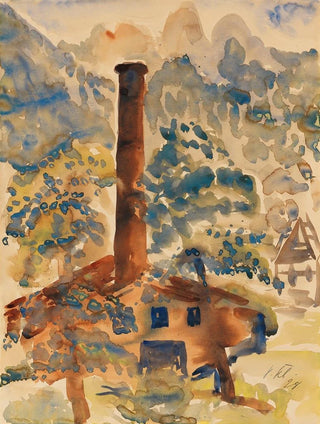Art print | Landscape with factory - Paul Kleinschmidt


View from behind

Frame (optional)
In the vast universe of art, certain works stand out for their ability to capture the essence of an era while evoking deep emotions. "Paysage avec usine - Paul Kleinschmidt" is one of those creations that, through its atmosphere both serene and industrial, invites us to reflect on the coexistence of nature and human activity. This artwork, which depicts a landscape where harmony sometimes seems compromised by the presence of a factory, immerses us in a fascinating visual dialogue between the natural world and technological progress. Through this art print, the viewer is transported to a time when industrial transformations shaped not only the landscape but also the soul of mankind.
Style and uniqueness of the work
Paul Kleinschmidt's style in "Paysage avec usine" is characterized by bold use of colors and shapes, creating an atmosphere that is both melancholic and contemplative. Earth tones, mixed with brighter accents, bring life to a scene where the factory, although present, does not dominate the space. On the contrary, it blends into the landscape, like a piece of a larger puzzle. The fluid lines and delicate contours of natural elements contrast with the more angular and abrupt forms of industrial architecture, illustrating the duality between nature and urbanization. This art print does not merely depict a landscape; it invites each observer to explore the emotions and reflections that this interaction between man and his environment provokes.
The artist and his influence
Paul Kleinschmidt, whose work is part of the modern landscape movement, managed to mark his era with a unique approach to representing the world. Influenced by the great masters of landscape, he nevertheless developed a personal style, imbued with sensitivity and reflection. His works, often tinged with a certain nostalgia, testify to a critical view of the transformations of his time. Kleinschmidt does not simply reproduce reality; he interprets it, questions it, and encourages us to consider alternatives. His artistic legacy lies in his ability to engage the viewer in a quest for visual and emotional identity.

Matte finish

View from behind

Frame (optional)
In the vast universe of art, certain works stand out for their ability to capture the essence of an era while evoking deep emotions. "Paysage avec usine - Paul Kleinschmidt" is one of those creations that, through its atmosphere both serene and industrial, invites us to reflect on the coexistence of nature and human activity. This artwork, which depicts a landscape where harmony sometimes seems compromised by the presence of a factory, immerses us in a fascinating visual dialogue between the natural world and technological progress. Through this art print, the viewer is transported to a time when industrial transformations shaped not only the landscape but also the soul of mankind.
Style and uniqueness of the work
Paul Kleinschmidt's style in "Paysage avec usine" is characterized by bold use of colors and shapes, creating an atmosphere that is both melancholic and contemplative. Earth tones, mixed with brighter accents, bring life to a scene where the factory, although present, does not dominate the space. On the contrary, it blends into the landscape, like a piece of a larger puzzle. The fluid lines and delicate contours of natural elements contrast with the more angular and abrupt forms of industrial architecture, illustrating the duality between nature and urbanization. This art print does not merely depict a landscape; it invites each observer to explore the emotions and reflections that this interaction between man and his environment provokes.
The artist and his influence
Paul Kleinschmidt, whose work is part of the modern landscape movement, managed to mark his era with a unique approach to representing the world. Influenced by the great masters of landscape, he nevertheless developed a personal style, imbued with sensitivity and reflection. His works, often tinged with a certain nostalgia, testify to a critical view of the transformations of his time. Kleinschmidt does not simply reproduce reality; he interprets it, questions it, and encourages us to consider alternatives. His artistic legacy lies in his ability to engage the viewer in a quest for visual and emotional identity.






